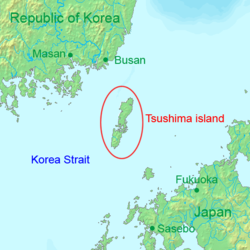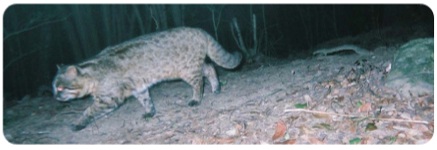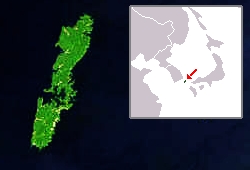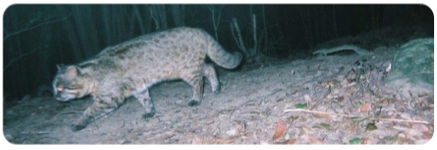Another Korean Area Treasure: Tsushima Wildcat
Posted by: Loren Coleman on November 24th, 2010
[With the continued attention on Korea, I pass along these 2008 and 2009 columns by Brent.]

Guest blogs from Japan by Brent Swancer:
In light of the 2008 info on the Iriomote wildcat, I thought people might be interested to know that there is another type of wildcat living on Tsushima island in Japan, which lies on the western side of Kyuushu island, between Japan and Korea.
The endangered Tsushima wildcat is considered to be a subspecies of leopard cat and is thought to have arrived from the Asian continent around 100,000 years ago. Although the exact taxonomy of the cat is disputed, it is a different subspecies from the Iriomote wildcat.
The cat was designated as a national treasure in 1971 and declared an endangered species in 1994. Over the years, it’s population has dwindled due to land development and the building of roadways, with cars being one of the major killers of the cats. Current estimates put their numbers at fewer than one hundred individuals.
Interestingly, the cats live mostly in the Northern part of the island. They were thought to have been wiped out in the Southern part since 1984, when the last known specimen from there was found as road kill.


The trail cam photos of a Tsushima cat (Prionailurus bengalensis euptilura) captured in 2007.
None were seen in the Southern area until 2007, when a set of automated trail cams commissioned by the Environmental ministry caught one of the elusive cats on film there, which has given hope that perhaps they have either held on or are repopulating that area.
Tsushima island has a land area of 273.6 square miles and a population of just under 40,000 people.



++++
Rare Japanese Wildcat Rediscovered

Map locates Tsushima Island between South Korea and Japan.
The Year 2009 proved to be a promising one for a rare type of Japanese wildcat, when a living specimen of Tsushima leopard cat was discovered in an area where the animals had long been feared extinct.
The Tsushima leopard cat (Prionailurus bengalensis euptilura) is an isolated subspecies of Asian leopard cat found only on the small island of Tsushima, Japan. The 273.6 sq mile island is located in the Korean Strait, 49.5 km (31 miles) from the Korean peninsula and 138 km (86 miles) from Japan’s Kyushu Island. The island’s population is 40,000. Tsushima leopard cats are similar in size and appearance to housecats, which they are often mistaken for. They are one of two endemic species of wildcat native to Japan, the other being the Iriomote wildcat found on Iriomote Island.

Tsushima Island is divided by artificial waterways into two separate islands; Kamijima, and Shimojima. The larger and more sparsely populated upper island, Kamijima, is home to an estimated 80 to 110 of the endangered wildcats. Until recently, it was thought that Kamijima was the sole remaining habitat of Tsushima leopard cats. The more populous lower island, Shimojima, is more heavily developed and it was thought for decades that the leopard cats had disappeared from there. The last confirmed physical specimen of Tsushima leopard cat on the lower island was a dead cat found on a roadway in 1984. No more cats were seen on Shimojima until 2007, when a trail cam snapped a picture of one, marking the first confirmation of cats in the area in over two decades.

The recent discovery of a live leopard cat on Tsushima’s lower island marks the first physical evidence of wildcats living here since 1984. The recently found cat was a 1,130 gram juvenile male, which has been estimated to have been born just this past spring. The cat, which was suffering from severe malnourishment, was found on a company property in the town of Izuhara. The cat will be nursed back to health by authorities.
Along with the related Iriomote wildcat, Tsushima leopard cats are important animals of discovery within cryptozoology. The two types of cat were not confirmed by science until the 1960s. Both varieties of cat are critically endangered and rarely seen, with numbers hovering around only a hundred individuals. The cats are threatened by habitat destruction and roads that bisect their territory. Road kills remain the most pressing threat to the animals’ continuing survival. On Tsushima’s upper island of Kamijima, 42 of the leopard cats have been killed on roadways since 1991.
Japanese biologists are hoping that this latest discovery of a live Tsushima leopard cat on the lower island is an indicator that more will be found, and that a breeding population may even still exist here.
+++
For clarification, here is a specific subspecies breakdown:
There is a “new” subspecies of leopard cat, called the Tsushima cat, which lives in Tsushima, a small island between Japan and Korea. It is considered to be the same subspecies as the Manchurian cat, except just a little darker in coloration. They hide in the forests on the mountains of this small island, where they remain unpersecuted.
Prionailurus bengalensis bengalensis — India to Indo-China and Yunnan.
Prionailurus bengalensis borneoensis — Borneo leopard cat; has reddish hue to coat.
Prionailurus bengalensis chinensis — China and Taiwan
Prionailurus bengalensis euptailura — Far east, eastern Siberia, aslo known as the Amur Leopard cat
Prionailurus bengalensis horsfieldi — Kashmir to Sikkim
Prionailurus bengalensis manchurica — Manchurian leopard cat; lives in dense tropical forests.
Prionailurus bengalensis trevelyani — North Kashmir to South Baluchistan, Pakistan
Prionailurus bengalensis javaensis — Java and Bali; dull greyish coloration.
Prionailurus bengalensis minutus — Philippines
Prionailurus bengalensis sumatranus — Sumatran leopard cat; lower spot density.
About Loren Coleman
Loren Coleman is one of the world’s leading cryptozoologists, some say “the” leading living cryptozoologist. Certainly, he is acknowledged as the current living American researcher and writer who has most popularized cryptozoology in the late 20th and early 21st centuries.
Starting his fieldwork and investigations in 1960, after traveling and trekking extensively in pursuit of cryptozoological mysteries, Coleman began writing to share his experiences in 1969. An honorary member of Ivan T. Sanderson’s Society for the Investigation of the Unexplained in the 1970s, Coleman has been bestowed with similar honorary memberships of the North Idaho College Cryptozoology Club in 1983, and in subsequent years, that of the British Columbia Scientific Cryptozoology Club, CryptoSafari International, and other international organizations. He was also a Life Member and Benefactor of the International Society of Cryptozoology (now-defunct).
Loren Coleman’s daily blog, as a member of the Cryptomundo Team, served as an ongoing avenue of communication for the ever-growing body of cryptozoo news from 2005 through 2013. He returned as an infrequent contributor beginning Halloween week of 2015.
Coleman is the founder in 2003, and current director of the International Cryptozoology Museum in Portland, Maine.










Thanks – to Loren for “recycling” this one and to m_m for keeping them coming! Other than the Sasquatch and Yeti (totally neutral assessment!), this kind of stuff is the meat of cryptozoology, and of Cryptomundo, I think.